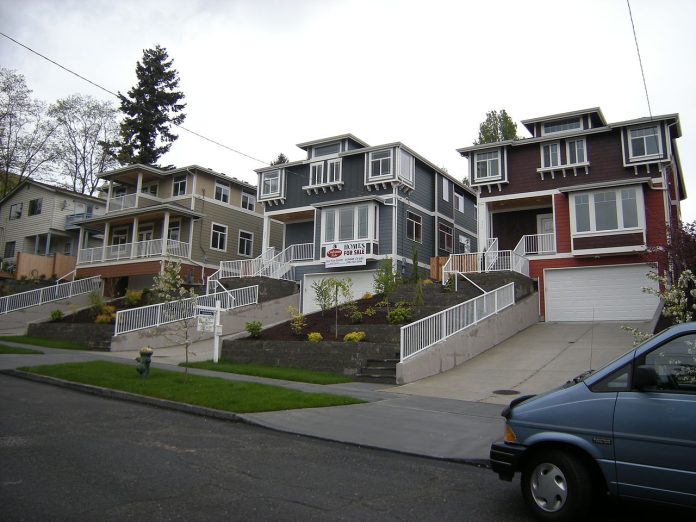This is a two-part series! The first part was a brief overview of the Growth Management Act, King County’s Urban Growth Boundary, and how we ended up with neighborhood plans. The second part will go into what the neighborhood planning documents actually say, what neighborhood planning did, and how Seattle’s homeowner-dominated neighborhood planning codified anti-renter bias, and where Seattle is headed.
Neighborhood plans are a weird thing. Many people have zero idea of their existence or history, and some of its most vocal defenders weren’t even living in Seattle during their creation. In many cases, the boosters of neighborhood plans are also the same people who opposed the affordable housing rezones, who opposed accessory dwelling unit liberalization, and who oppose safe streets and bike infrastructure (this last part is ironic, as most of the neighborhood plans are very vocal about increasing bike lanes).
Interestingly, Shelterforce magazine in 1999 claimed only 12,000 people participated in neighborhood planning (out of nearly 560,000 residents, a whopping 2%). More people moved to Seattle between 2018 and 2019 (16,900 per Office Financial Management) than participated in a planning process over 20 years ago that severely restricted where these new residents could live, as well as each of the five years preceding. There are 38 neighborhood plans, meaning the average Urban Village had 315 people working on it. Shelterforce also wrote the plans have their roots in keeping people out:
Yet the Neighborhood Planning Program has its origins in NIMBYism. The city began the program after residents of wealthier, single-family neighborhoods reacted against an earlier proposal by then Mayor Norman Rice, the city’s first black mayor, to create “Urban Villages” in various city neighborhoods by changing zoning codes to allow greater housing density and pedestrian-oriented development. The proposal called for developing more affordable multifamily housing throughout the city, including in wealthier single-family neighborhoods.
Sound familiar? Remember how the city looked at eliminating single-family zoning in the late 1970s, only to have wealthy neighborhoods rise up and kill a proposal to allow low-income duplexes and triplexes in single-family zones? Or recently, how homeowners tried to kill affordable housing through a modest rezone in more of the city?
The affordable housing component of then-Mayor Norm Rice’s original Urban Village plan called for 25% affordable housing in Urban Villages. In 1994, The Seattle Times reported that 250 West Seattle residents showed up to a meeting to criticize the Urban Village plans, stating they already had enough affordable housing, and that the Urban Village Strategy contained “neighborhood-killing viruses” that would lead to urban slums. West Seattle has over 80,000 residents today.
It should be noted this affordable housing component is mentioned in several of the neighborhood planning documents, largely negatively or how in the neighborhood planning process, it was removed completely. This component was eventually removed from the overarching Urban Village strategy, and none of the neighborhood plans or urban villages had a 25% affordable housing requirement.
Neighborhood planning, which was supposed to be about accommodating new growth, resulted in plans largely influenced by homeowners working to downzone, reduce State Environmental Policy Act thresholds to raise construction costs, keep affordable housing out of their neighborhoods, and prevent new housing from being built near them. And this was largely by design.
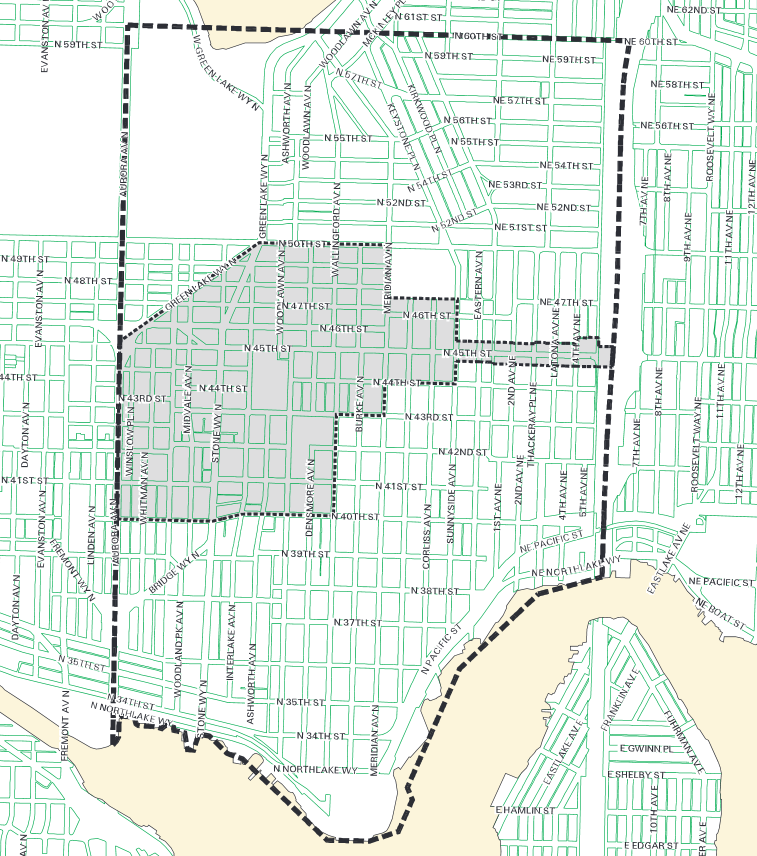
The neighborhood planning areas have a catchment that is much larger than the Urban Village, and because of the century of classist zoning, this means Urban Villages are almost exclusively surrounded by–yep, you guessed it–single-family zoning. The city did not have any mechanisms in place to ensure residents living in Urban Villages had more of a say on how things would change than those living in the planning areas surrounding them. This is a poison pill that effectively ensured greater participation by homeowners, who used the process to preserve the status quo.
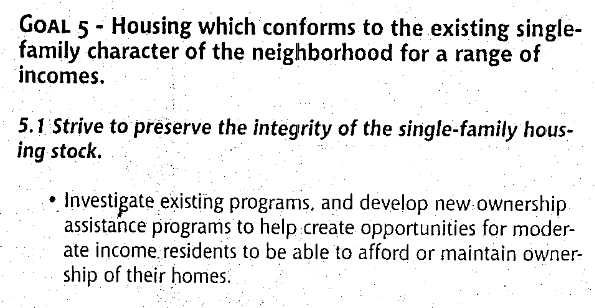
So what sort of things do these documents state? Several of them, even though they’re supposed to be planning documents about increasing housing and growth, specifically talk about protecting the existing character of single-family homes and preventing new housing. The scourge of duplexes and small apartments that were legal decades before.
Green Lake Plan: Snob Zoning
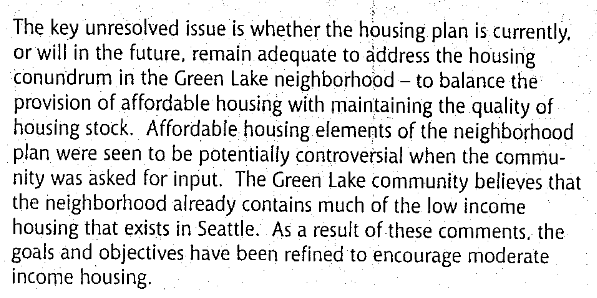
Several of them state their neighborhood already has enough low-income housing or that the affordable housing elements were seen as being too controversial and so there was no need to accommodate any more. The Green Lake Neighborhood Plan said the community of Green Lake already contained much of the low-income housing that existed in Seattle. This wasn’t true 25 years ago and it certainly isn’t true today.
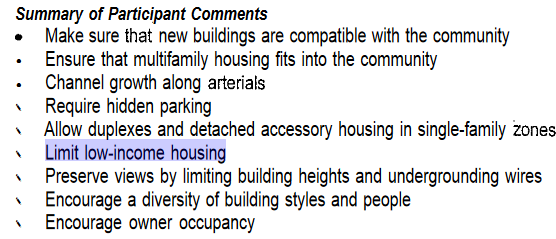
Morgan Junction Plan Opposes Low-Income Housing
The Morgan Junction plans talk about how residents wanted to specifically limit low-income housing. How these documents were taken seriously, I will never understand.
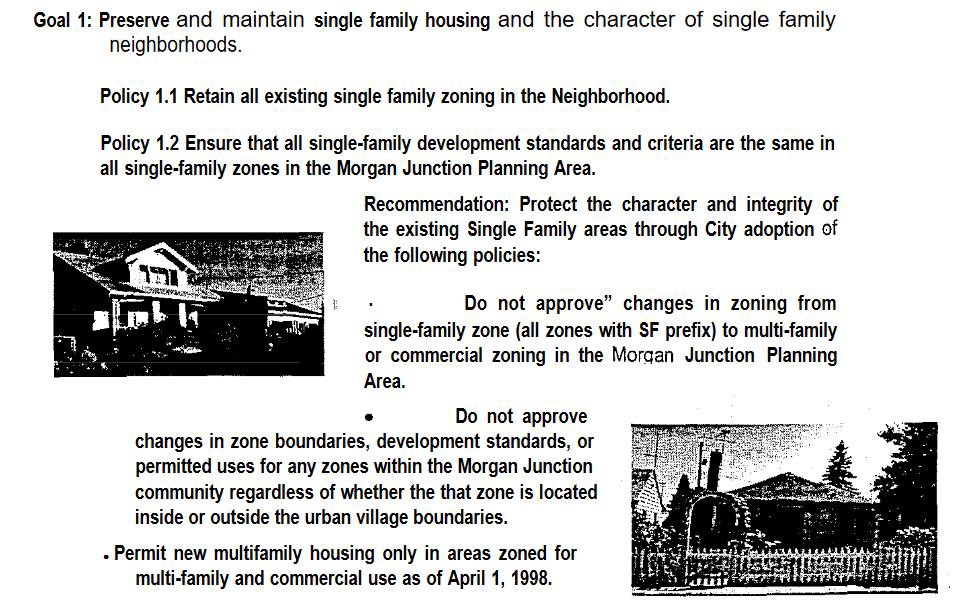
Phinney/Greenwood’s Disappearing Act
In the planning process, the city proposed Urban Village boundaries, but the homeowner-dominated neighborhood planning groups would often carve out large portions. Would you have guessed single-family zoning?
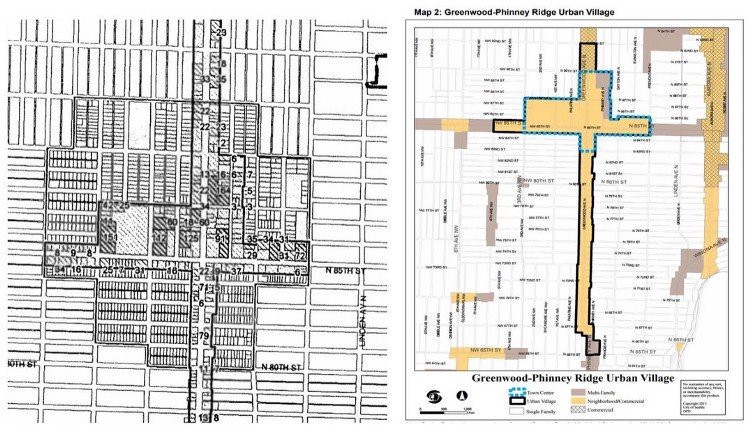
Phinney/Greenwood was the most egregious: 32 blocks of what today could allow small-scale multifamily housing were completely removed. All of the parks were gerrymandered out of the Urban Village and then the neighborhood plan stated there was an open space deficit to address. All that remained of the Urban Village boundary was a half-deep block along N 85th St and Phinney/Greenwood Ave N. What this did was focus all of the new housing growth in the neighborhood on to the arterial where existing businesses were located.
Fremont: Center of Universe Sucked into Black Hole

The Fremont neighborhood plan, dominated by homeowners and property owners, removed a third of the city’s proposed Urban Village boundary (south of the Ship Canal) and then didn’t change any of the zoning. They claimed this would preserve Fremont as a place affordable to artists. Does anyone think Fremont is affordable to artists today?
Queen Anne: A Renter-Majority Neighborhood Planned by Homeowners

The Queen Anne neighborhood plan is notable for complaints about “threats to single family neighborhoods”, and “blockage of views”. Their process also didn’t change zoning beyond what already existed. And one of the top Policy Goals of the Queen Anne neighborhood plan was to “[p]rotect the existing character of Queen Anne’s Single family neighborhoods”. At the time, Queen Anne’s planning area was 31,000 residents, and overwhelmingly renter. It still is. They were even nice enough to allow existing non-conforming uses to remain, but don’t you dare build a duplex or small apartment in most of the neighborhood.
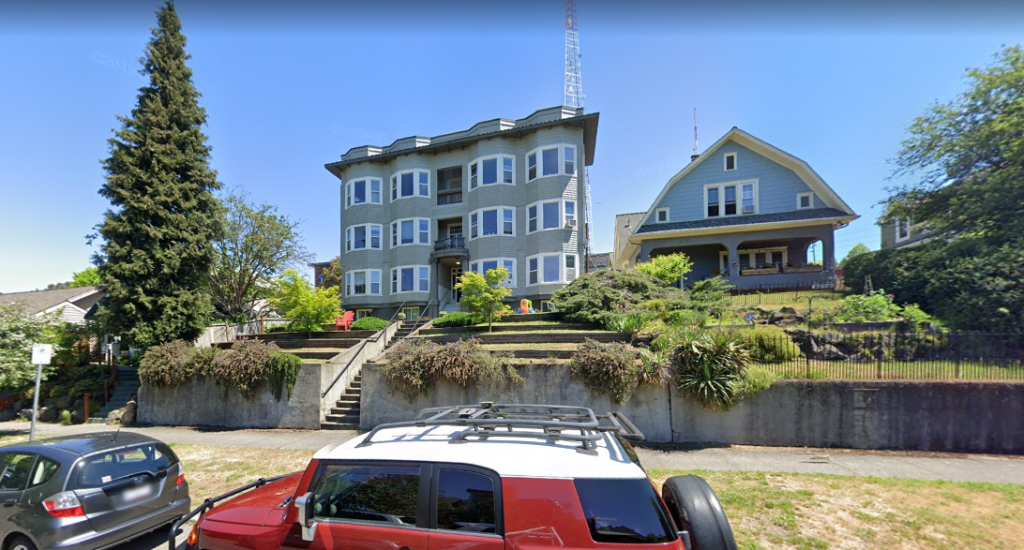
Many of the plans talk about encouraging homeownership and how homeowners make better residents. There is persistent anti-renter bias in these documents.
No Racial Equity Lens
At the time that neighborhood planning in Seattle was undertaken, there was no Race and Equity Toolkit. And because of the exclusionary and racist roots of Seattle’s zoning the preceding decades, this means that the neighborhood plans effectively just allowed a little more density where density was already allowed. It is a continual process in Seattle of preventing new housing from the majority of the city, and focusing it where existing housing and businesses already exist. This is one of the reasons Councilmember Teresa Mosqueda pushed to get the Urban Village strategy reviewed under the RET.
Wealthiest Areas Avoid Urban Village Designation
Just as interesting as to which neighborhoods were planned, is which ones don’t have any neighborhood plans at all: Magnolia (median single-family home value of $980,000), whose walkable neighborhood center has schools, parks, playgrounds, a pool, and a library. Multifamily housing? Virtually none near in walking distance to these amenities.
Laurelhurst (median single-family home value of $1.55 million), with much of the same amenities? Nope, despite having a school, community centers, parks, and being a really quick ride to a light rail station.
How about Montlake (median single-family home value $1.2 million), with its great parks, school, community center, new library that is less than three-quarters of a mile from a light rail station, and quick access to the east side? In Vienna, where they’re building new light rail stations, there are four- to six-story buildings being added that are three-quarters of a mile from a light rail station.
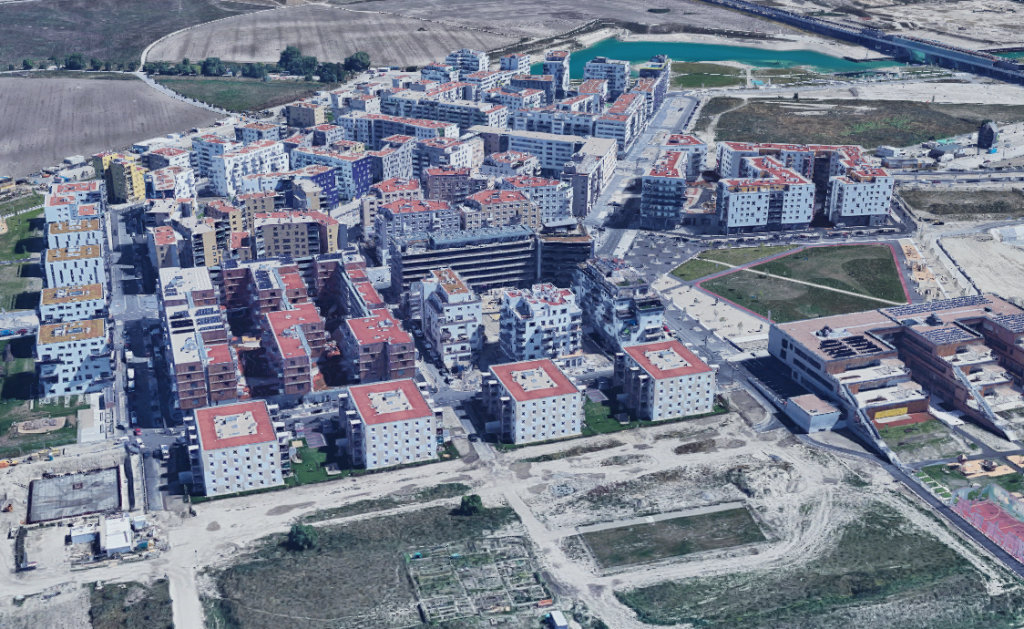
Ravenna, Bryant, Wedgewood and Maple Leaf–which also have small neighborhood centers, great parks, good schools, and access to incoming high capacity transit–also avoided Urban Village designation. All of these neighborhoods somehow avoided an Urban Village. I wonder what it could have been…

A 2008 University of Washington studio’s review of the neighborhood plans noted many of these same things, specifically that maintaining status quo was a common theme. Another notable comment:
Other plans within the sector focus less attention on affordable housing issues and offer few tactics to address rising housing costs, despite vision statements that explicitly aim for a diversity of residents of all income levels.
Much Needed Reforms
In 2017, then Mayor Ed Murray announced the city was cutting formal ties (and funding) with district councils involved in neighborhood planning, in part because these councils were dominated by homeowners. Since then, the city has been trying to get more representative forms of feedback and engagement, although under the present administration, much of that seems to have floundered.
Shortly thereafter, the Seattle Renters Commission was announced, long overdue given the disproportionate power and representation half of the city has had for decades. Last Fall, the Seattle Planning Commission dropped their wonderful “Neighborhoods for All” report, which emphatically stated, “[c]urrent zoning does not promote equitable access to public amenities and assets.”
This is a welcome departure from a body that even a few years ago, was still putting out letters, as they had 15 years earlier, stating new housing should be off limits to the majority of the city, specifically, things like this:
…the City should encourage higher density residential development where it is consistent with neighborhood plans and the urban village strategy. The City should also continue to pursue creative lower density housing choices such as cottage housing and detached accessory dwelling units in urban villages and where neighborhoods have expressed acceptance of such housing.
These disparities, with their roots in the original zoning maps, not only affect housing costs and transportation; they affect schools as well. KUOW had a report last year about how wealthy neighborhoods, that in the past have worked to exclude affordable housing, are also able to use their wealth to supplement their schools deficiencies, further exacerbating inequality in our city.
The neighborhood plans, while well-intentioned, enshrined anti-tenant, anti-housing regulations in one of the fastest growing cities in the country. As a result, there has been very uneven growth in our city, according to reporting by The Seattle Times. Seattle is becoming more and more majority renter (over 55% of the city in the latest American Community Survey data), but affordable multifamily housing is illegal in most of the city. Small apartments can’t be added in many walkable neighborhoods because of the anti-tenant bias codified in our neighborhood plans. Could this have been avoided? Could the plans be improved? What would neighborhood plans look like if Seattle had abolished single-family zoning in the 1970s? What would neighborhood plans have looked like if planning groups had been dominated by renters, as nearly every single Urban Village in the city is?
Given how they preserve and promote sprawl, the neighborhood plans are antithetical to sustainability and livability. Candidates who argue we should bring them back are promoting unsustainable and biased plans. It is long past time to right the disparity enshrined in our planning documents. We have candidates that understand the exclusionary nature and bias of where things are today, and are thinking of ways to address those issues. And we have candidates who think the status quo is fine, there is no bias in our neighborhood plans, and renters shouldn’t be allowed to live in most of the city. The neighborhood plans were designed to inhibit inclusive neighborhoods in the city. But they don’t have to be that way. The choice this year is more stark than almost any previous moment in our history.
This is a cross-post from Mike Eliason’s medium. The featured image is by Joe Mabel.
Mike is the founder of Larch Lab, an architecture and urbanism think and do tank focusing on prefabricated, decarbonized, climate-adaptive, low-energy urban buildings; sustainable mobility; livable ecodistricts. He is also a dad, writer, and researcher with a passion for passivhaus buildings, baugruppen, social housing, livable cities, and car-free streets. After living in Freiburg, Mike spent 15 years raising his family - nearly car-free, in Fremont. After a brief sojourn to study mass timber buildings in Bayern, he has returned to jumpstart a baugruppe movement and help build a more sustainable, equitable, and livable Seattle. Ohne autos.


